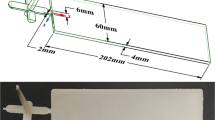Abstract
Authors designed and built a mold-type slit rheometer. The slit rheometer has a vertical flow channel and interchangeable cores with various slit thicknesses. It is installed in an injection molding machine like a general mold. The melt is supplied by the plasticizing unit of the injection molding machine. The melt temperature supplied by the plasticizing unit varies by the plasticizing conditions and the shear heating effect in the nozzle and the sprue. In this study, the effects of the plasticizing conditions and the shear heating in the nozzle and the sprue were examined, and the influence of the melt temperature variation on the viscosity measurement was analyzed experimentally and numerically. A temperature sensor was designed to measure the melt temperature in the sprue. Its tip is fully immersed in the melt to have a higher sensitivity. Two resins with different thermal sensitivities were used to examine the effect of resin on the melt temperature variation. To check the shear heating effect in the nozzle and the sprue, two sets of the nozzle and the sprue with different orifice sizes were used. The numerical analysis was done by commercial software (Moldex3D) to check the melt temperature from the nozzle to the slit channel. The viscosity of long-fiber reinforced polypropylene (PP) was measured with various slit channel thicknesses to verify the reproducibility. The standard deviation of the viscosity values against the Cross model fitting curve was 3.01 Pa·s. The viscosity of acrylonitrile butadiene styrene (ABS) measured using the slit rheometer was compared with values obtained from a capillary rheometer and commercial database.
Similar content being viewed by others
References
Aho, J., L. Moberg, S. Syrjälä, and P. Järvelä, 2011, Injection molding machine with height-adjustable slit die for rheological measurements of polymer melts under processing conditions, Annu. Trans. Nord. Rheol. Soc. 19, 125–133.
Amano, O. and S. Utsugi, 1988, Temperature measurements of polymer melts in the heating barrel during injection molding. Part I. Temperature distribution along the screw axis in the reservoir, Polym. Eng. Sci. 28, 1565–1571.
Blutmager, A., M. Varga, T. Schmidt, A. Pock, and W. Friesenbichler, 2019, Abrasive/Erosive wear on MMCs in plastic molds as a function of volumetric flow rates and glass fiber distribution, Polym. Eng. Sci. 59, E302–E311.
Cengel, Y.A. and J.M. Cimbala, 2004, Fluid Mechanics Fundamentals and Applications, 2nd ed., McGraw-Hill Higher Education, New York, 340–345.
Cox, H.W. and C.W. Macosko, 1974, Viscous dissipation in die flows, AIChE J. 20, 785–795.
Dealy, J.M. and T.O. Broadhead, 1993, Process rheometers for molten plastics: A survey of existing technology, Polym. Eng. Sci. 33, 1513–1523.
Eswran, R., H. Janeschitz-Kriegl, and J. Schijf, 1963, A slit viscometer for polymer melts, Rheol. Acta 3, 83–91.
Fernandez, A., M. Muniesa, and C. Javierre, 2014, In-line rheological testing of thermoplastics and a monitored device for an injection moulding machine: Application to raw and recycled polypropylene, Polym. Test 33, 107–115.
Friesenbichler, W., I. Dureteck, J. Rajganesh, and S.R. Kumar, 2011, Measuring the pressure dependent viscosity at high shear rates using a new rheological injection mould, Polimery 56, 58–62.
Friesenbichler, W., A. Neunhäuserer, and I. Duretek, 2016, Rheometry of polymer melt using processing machines, Korea-Aust. Rheol. J. 28, 167–174.
Gim, J.S., J.S. Tae, J.H. Jeon, J.H. Choi, and B.O. Rhee, 2015, Detection method of filling imbalance in a multi-cavity mold for small lens, Int. J. Precis. Eng. Manuf. 16, 531–535.
Hopmann, C., T. Fischer, and J. Heinisch, 2017, Online melt viscosity measurement during injection molding for new control strategies, Annual Technical Conference 2017 (ANTEC 2017), Anaheim, USA, 1560–1565.
Jeon, J.H., J.S. Gim, and B.O. Rhee, 2016, The melt temperature variation in the barrel of injection molding machine, Annual Technical Conference 2016 (ANTEC 2016), Anaheim, USA, 1156–1160.
Knappe, W. and E. Krumböck, 1986, Slip flow of non-plasticized PVC compounds, Rheol. Acta 25, 296–307.
Laun, H.M., 1983, Polymer melt rheology with a slit die, Rheol. Acta 22, 171–185.
Laun, H.M., 2003, Pressure dependent viscosity and dissipative heating in capillary rheometry of polymer melts, Rheol. Acta 42, 295–308.
Lee, J.H., 2016, Research on the residual fiber length in injection molding process for glass fiber reinforced polypropylene, M.S. Thesis, Ajou University.
Lee, M.C. and S.J. Han, 2002, Viscosity behaviors of epoxy molding compound for the semiconductor microchip encapsulant, Kor. Chem. Eng. Res. 40, 310–315.
Lohr, C., S. Dieterle, A. Menrath, K.A. Weidenmann, and P. Elsner, 2018, Rheological studies on gas-laden and long glass fiber reinforced polypropylene through an inline high pressure capillary rheometer in the injection molding process, Polym. Test 71, 27–31.
Moon, D., A.J. Bur, and K.B. Migler, 2008, Multi-sample microslit rheometry, J. Rheol., 52, 1131–1142.
Thomasset, J., P.J. Carreau, B. Sanschagrin, and G. Ausias, 2005, Rheological properties of long glass fiber filled polypropylene, J. Non-Newton. Fluid. Mech. 125, 25–34.
Wales, J.L.S., J.L. den Otter, and H. Janeschitz-Kriegl, 1965, Comparison between slit viscometry and cylindrical capillary viscometry, Rheol. Acta 4, 146–152.
Winter, H.H., 1977, Viscous dissipation in shear flow of molten polymers, Adv. Heat Transf. 13, 205–267.
Acknowledgments
This research did not receive any specific grant from funding agencies in the public, commercial, or not-for-profit sectors.
Author information
Authors and Affiliations
Corresponding author
Additional information
Publisher’s Note
Springer Nature remains neutral with regard to jurisdictional claims in published maps and institutional affiliations.
Rights and permissions
About this article
Cite this article
Han, E., Gim, J., Kim, B. et al. Examination of the melt temperature stability of the mold-type slit rheometer affected by plasticizing conditions and the shear heating in the nozzle and sprue. Korea-Aust. Rheol. J. 33, 151–162 (2021). https://doi.org/10.1007/s13367-021-0014-0
Received:
Accepted:
Published:
Issue Date:
DOI: https://doi.org/10.1007/s13367-021-0014-0



